Abstract
Having garnered significant attention in the scientific community over the past decade, wire-arc directed energy deposition (arc-DED) technology is at the heart of this investigation into additive manufacturing parameters. Singularly focused on Invar as the selected material, the primary objective revolves around devising a virtual sensor for the indirect size measurement of the bead. This innovative methodology involves the seamless integration of internal signals and sensors, enabling the derivation of crucial measurements sans the requirement for direct physical interaction or conventional measurement methodologies. The internal signals recorded, the comprising voltage, the current, the energy from the welding heat source generator, the wire feed speed from the feeding system, the traverse speed from the machine axes, and the temperature from a pyrometer located in the head were all captured through the control of the machine specially dedicated to the arc-DED process during a phase of optimizing and modeling the bead geometry. Finally, a feedforward neural network (FNN), also known as a multi-layer perceptron (MLP), is designed, with the internal signals serving as the input and the height and width of the bead constituting the output. Remarkably cost-effective, this solution circumvents the need for intricate measurements and significantly contributes to the proper layer-by-layer growth process. Furthermore, a neural network model is implemented with a test loss of 0.144 and a test accuracy of 1.0 in order to predict weld bead geometry based on process parameters, thus offering a promising approach for real-time monitoring and defect detection.
1. Introduction
In recent decades, wire-arc directed energy deposition (arc-DED) technology has gained significant traction within the scientific community, emerging as a focal point to produce additive components. A notable advantage of arc-DED lies in its robust deposition ratios, positioning it favorably among other additive methodologies [1,2]. This heightened attention has catalyzed a surge in research, propelling the exploration of 3D-printed part fabrication [3]. Notably, aerospace applications have taken a prominent role, showcasing promising outcomes [4,5]. Of the arc-DED techniques, gas metal arc welding (GMAW) stands out for its elevated deposition rates, surpassing other wire-based technologies, such as plasma-based arc-DED and gas tungsten arc welding (GTAW) [6,7]. The utilization of Invar, an alloy, within this realm adds an intriguing dimension, leveraging its distinctive mechanical properties [8,9]. Comprising predominantly iron (64%) and nickel (36%) alloys, Invar finds purpose across diverse fields [10,11]. Renowned for its superior dimensional stability and mechanical prowess in cryogenic environments, Invar plays a pivotal role in applications demanding precision and reliability, as seen in metrology and aerospace components. The formidable challenge posed by its malleability and low heat conductivity in machining scenarios drives the interest in additive manufacturing for Invar, offering preforms aligning closely with final part geometries [12,13,14]. Invar’s application through PBF-LB/M has revealed optimal energy density ranges for mechanical properties [15], along with characteristic microstructures [16].
To advance the implementation of arc-DED technology in complex geometries, the fine-tuning of processes from initial passes has emerged as a key focus [17]. Understanding the geometry of zero beads has been central, often centering on models that correlate wire feed speed and travel speed (TS) with bead geometry characteristics [18,19,20]. While conventional approaches maintain transverse bead geometry as a constant during deposition, limited studies acknowledge longitudinal variations [21]. Pinto et al. [22] reported the real-time determination of weld bead dimensions using passive vision systems and digital image processing. The proper construction of initial beads fundamentally underpins the accurate manufacturing of final walls. Xiong et al. [23] delve into layer-by-layer forming characteristics analysis in GMAW-based arc-DED, while Donghong et al. [24] address corner piece generation for intricate geometries. Amid the importance of final bead geometry analysis, the challenge of online process control remains pronounced [25]. Infrared pyrometry techniques for melt-pool measurement have found favor within integrated process monitoring systems [26,27,28], some even hinting at symmetries in the generated geometries [9], thus offering a realm of exploration for the research community.
Regarding arc-DED, as the technology continues to advance, it becomes imperative to explore the testing methodologies to contribute to its optimization. Among the forefront of the testing methods is the integration of artificial intelligence (AI) for defect detection in arc-DED [29]. Researchers have developed sophisticated AI applications, tailored to identifying flaws during the manufacturing process, thus enhancing quality control and efficiency. Additionally, in situ ultrasonic testing (UT) emerges as a pivotal non-destructive technique, utilized during arc-DED component construction. Operating at temperatures up to 100 °C, UT plays a crucial role in defect detection, ensuring the integrity and reliability of fabricated parts [30].
Furthermore, novel control strategies, such as reinforcement learning, have demonstrated promising outcomes in addressing inherent challenges within arc-DED, such as model non-linearity and process uncertainties. These adaptive strategies empower manufacturers with enhanced control over process parameters, facilitating greater precision and consistency. Additionally, while arc-DED presents opportunities for producing medium-to-large-scale metallic components, ongoing efforts in materials characterization and defect mitigation remain essential in the optimization of product quality and performance [31].
Throughout history, humanity’s quest for improved materials and fabrication techniques has driven innovation. Contemporary technological advancements have paved the way for novel materials with unprecedented applications. Among these, Invar 36, or FeNi36, has emerged as a versatile Fe-based alloy with exceptional properties. Its notably low coefficient of thermal expansion (CTE) makes it a standout choice. Conventionally, Invar 36 is machined, yet its poor machinability, which is due to its high ductility, low heat conductivity, and substantial work hardening, has sparked exploration into alternative manufacturing methods. Additive manufacturing (AM) stands out as a solution, offering efficient material usage and design flexibility. While the previous literature Manoj Guptahas predominantly explored laser-based powder bed fusion (PBF-LB/M) and power/laser directed energy deposition techniques, the usage of wire materials and electric arcs in AM is garnering renewed attention due to its potential to overcome the limitations of powder-based methods.
Focusing on the wire-based approach, this article delves into the advantages of the arc-DED process, emphasizing its applicability for large- or medium-sized components due to its high deposition rates and cost-effectiveness. Beyond this, the study ventures into the exploitation of modelling techniques to delineate the geometry, with the aim of determining target control parameters. These identified parameters will subsequently serve as the output for a neural network, into which welding and machine parameters are the input. This novel approach not only contributes to improving the understanding and control of the additive manufacturing process with Invar material, but also aligns with the broader goal of raising precision and efficiency in the manufacturing domain.
Taking advantage of arc-DED technology, which has been booming in the scientific community for the last decade, this research focuses on developing a virtual sensor for the indirect measurement of the bead size in Invar material. This innovative methodology integrates internal signals and sensors to obtain crucial measurements without the need for direct physical interaction or conventional measurement methods. The novelty of this paper is encapsulated in the innovative utilization of symmetry analysis techniques to address pivotal inquiries. These encompass an exploration of the geometry of zero beads via symmetry coefficient analysis in both longitudinal and transverse planes, an investigation into the symmetry of the final wall through the use of scanning laser technology, and a pioneering approach to melt-pool monitoring integrating infrared thermography techniques.
2. Materials and Methods
2.1. Experimental Setup and Material
In the experimental phase of this study, Invar, also known as FeNi36, a wire UNS K93600 with a diameter of 1.2 mm, was selected as the foundational material. The baseplate utilized in the study was composed of 8 mm thick sheets of Invar (UTP A 8036 S). The mechanical properties of this material, particularly its coefficient of thermal expansion (CTE), stand as notable characteristics, driven by its specific chemical composition. The chemical properties of the wire, as provided by the supplier, are summarized in Table 1. It is worth noting that the material employed in the tests originates from the same wire coil to ensure consistent chemical and metallurgical attributes. Also, in Table 1, a comparison of various thermal and mechanical properties of Invar obtained through different processes is provided, enhancing the overall support for the use of Invar in the context of arc-DED.

Table 1.
The chemical composition of the invar wire used during experimentation, and the thermal and mechanical properties of Invar after arc-DED in the literature.
2.2. Experimental Equipment
The experimentation was conducted at the Addilan V0.1 manufacturing center, specializing in arc-DED technology. The setup includes an EWM brand generator (Mündersbach, Germany), Titan XQ 400 AC puls DW, and an M drive 4 Rob5 XR RE wire feeder, as depicted in Figure 1. Additionally, the setup is equipped with a laser profilometer (Laser Scanner Q4 Series) and a compact Optris pyrometer, which is placed on the vicinity of the nozzle. The chosen generator mode was the pulsed GMAW mode specified by the manufacturer, enabling the introduction of a pulsed intensity signal into the supplied wire. The MC500 Weld Camera (Redman) offered a visual window into the deposition process from an external perspective. A shielding gas mixture of Ar (97.5%) and CO2 (2.5%) was utilized, with a flow rate of 17 L/min. The nozzle diameter used was 20 mm, accompanied by a 15 mm stick-out, and the wire diameter employed was 1.2 mm.
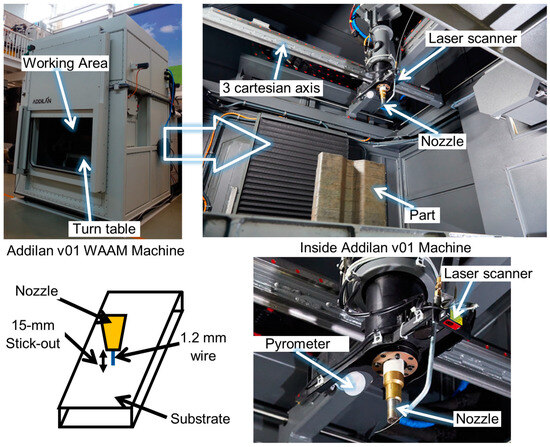
Figure 1.
The experimental setup for Invar manufacturing based on GMAW.
2.3. Experimental Procedure and Parameters
The experimentation unfolded in two distinct phases. The initial phase focused on producing various zero beads to refine the optimal deposition parameters. In the subsequent phase, utilizing the optimized parameters, a larger wall was fabricated to assess the accuracy of the geometry achieved. During the wall-manufacturing process on a fixed table, the substrate was secured and prepared by cleaning before welding. The software programmed with manufacturing parameters for the walls was loaded, specifying the start and end points of welding to determine the wall length (100 mm). The wall was then meticulously constructed, with layers of beads added in a layer-by-layer manner. The stipulated growth per layer was set at 2.5 mm, and a geometric laser profilometer (Laser Scanner Q4 Series) was used to correct and determine the welding point for the subsequent layer. Table 2 encapsulates the experimental design for process optimization. In considering bead geometry, the relationship between the wire feed speed and the traverse speed emerges as pivotal in determining weld bead geometry. This ratio dictates material deposition per unit length, profoundly shaping the ultimate form of the weld bead. The precise adjustment of this ratio is paramount for controlling critical geometric parameters like bead width and height, thereby influencing the weld quality and mechanical properties. The ratio is calculated following Equation (1), and the energy per length (kJ/cm) is calculated following Equation (2).

Table 2.
The design of experiments for process optimization.
The profilometer is employed to assess the geometry of the beads, positioned perpendicular to the substrate, with its movement analogous to that of the welding torch. This integration within the same head ensures that the scanning trajectory of the profilometer is equivalent to the torch’s path during bead deposition, aiming to create a virtual sensor for indirectly measuring bead size. This utilizes internal signals and sensors, bypasses conventional measurement techniques, and integrates a feed-forward neural network (FNN) model for accurate real-time monitoring and defect detection. The time between each of the tests was established to be sufficient for both the sheet and the beads to reach room temperature.
3. Results
This section presents the experimental outcomes and the discussions related to the arc-DED process applied to Invar. The chapter is structured into three interconnected subsections, each focusing on distinct aspects of the study. The first segment focuses on the measurement results pertaining to the bead profile, shedding light on the geometry of the initial bead and its implications for process parameters. The subsequent segment unveils the acquisition and analysis of current and voltage signals, offering insights into the dynamic nature of the process. Notably, the final facet of this chapter is dedicated to exploring the potential application of a virtual sensor for height measurement. This application leverages the signals from the generator and wire tractor, aiming to ascertain the height based on these instrumental inputs.
These activities help in the application of arc-DED technology to Invar to develop a virtual sensor for the indirect measurement of the bead size, taking advantage of internal signals and sensors without conventional measurement methods, and implementing a feed-forward neural network (FNN) model for real-time monitoring and highly accurate defect detection.
These interconnected components synergistically contribute to a holistic comprehension of the arc-DED process on Invar, as well as its implications for geometric precision and manufacturing performance.
3.1. The Measurement and Modeling of Zero Bead Geometry
The zero bead (Figure 2), the first pass of material deposited during arc-DED, plays a crucial role in determining the final geometry and properties of the deposited material. Accurately measuring and modeling the zero bead geometry is essential for optimizing arc-DED parameters and ensuring the consistent quality of the parts. The arc-DED process exhibits a dynamic molten pool, contributing to a challenge in achieving consistent weld bead geometry, particularly at the beginning (arc striking) and end (arc extinguishing) stages.
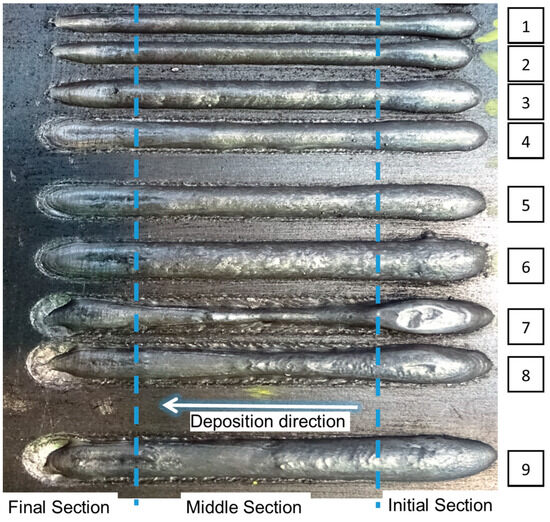
Figure 2.
Zero bead morphology for the different manufacturing conditions.
The image shows a top view of a bead deposited using arc-DED technology. In the setup, the beads are 100 mm long, although the distance between them is not constant. The deposition process forms a molten pool, which contributes to a challenge in achieving consistent weld bead geometry, particularly at the beginning (arc striking) and end (arc extinguishing) stages.
In the arc-DED process, the material deposits into a non-constant molten pool along its trajectory. The material tends to flow towards the hotter region, resulting in a tendency to accumulate at the back of the trajectory, leaving a certain over-dimension at the rear section. Consequently, the initial section may exhibit increased height and width, further compounded by the arc striking effect [33]. In the middle section, a quasi-stable situation is achieved, characterized by more continuous height and width. Here, the material experiences a relatively balanced state amid the dynamic molten pool, contributing to a more uniform bead geometry. However, as the process approaches its final section, the bead becomes narrower and lower, influenced by both the arc extinction phenomenon and the decreasing molten material flux. This final section reflects a distinctive geometry due to the combined effects of the reduced material flow and the arc extinguishing process.
The bead has a more uniform width and a smoother surface finish in the central section. It is important to note that the variations in the bead geometry seen in the image are relatively small. The study encompasses the central 46 mm of the 100 mm bead, as delineated by the blue dashed lines, incorporating the relevant values within this specified region. However, understanding these variations is important for ensuring consistent part quality and optimizing material properties. In the context of this image, the analysis will focus on the middle section of the bead, where the bead geometry is most uniform and consistent. By measuring and modelling the bead geometry, knowledge is gained that provides crucial information for designing complete components and effectively controlling the arc-DED process. This understanding of bead geometry is critical for the tailoring of the manufacturing process, thus ensuring optimal results and improving the overall quality of the manufactured parts.
The presented method for measuring the geometry of the zero bead consists of scanning the surface of the bead with a laser profilometer at 46 control points in the middle section of the bead. The laser profilometer precisely measures the distance between the laser beam and the bead surface at a series of discrete points, thus capturing a detailed representation of the bead’s transversal profile. The center of mass of the function formed by the measured profile points is calculated (Figure 3a). To do this in two dimensions, it can be found by first dividing the domain of the function into a regular grid of points. Then, the weighted average of the coordinates of these points can be calculated, where the weights are the values of the function at these points. Equation (3) for xcm and zcm represents the calculation of the center of mass in the x and z directions, as shown in Figure 3a, respectively, where xi and zi are the point clouds of the profile, and mi represents the mass associated with each distance component. Equation (3) shows the formula for the center of mass (xcm, zcm).
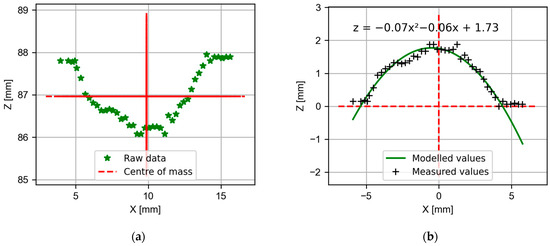
Figure 3.
Zero bead morphology: (a) point cloud and center of masses of the zero bead and (b) the modelled parabola for the profile.
These equations give you the coordinates of the center of mass for a two-dimensional object with either continuous or discrete mass distribution. Adjust the integrals or sums based on the specific form of your mass distribution. The reference plane or dimension 0 is defined using the profilometer, where the initial and final sections of the bead are detrended and adjusted to the zero reference of the plane. This adjustment ensures that the zero reference of the plane aligns with the bead’s starting and ending points, therefore providing a standardized reference point for the measurements. The data can then be used to fit a parabolic equation, representing the idealized parabolic shape of the zero bead (Figure 3b). The fitted parabola provides valuable insights into the bead’s geometry, including its height and width. Across the 46 profiles extracted from the initial tested bead, the R-squared values vary between 0.807 and 0.948, averaging at 0.887. On average, this indicates that the model accounts for 88.7% of the data variability.
To further enhance the accuracy of the bead geometry representation, 3D modeling techniques can be employed, as can be seen in Figure 4. In this representation, the fitted parabola is obtained from the 46 measured profiles of the bead in the middle section at a rate of 1 profile per mm in order to develop a full 3D model. By combining the fitted parabola with the measured bead dimensions, a comprehensive 3D model can be developed. This model provides a holistic view of the bead’s shape, size, and distribution of material. The comparison of the 3D model to the theoretical models of zero beads provides valuable insights into the influence of arc-DED parameters on bead geometry. By understanding the relationship between the process parameters and bead shapes, engineers can optimize arc-DED settings, allowing them to achieve the desired bead geometry and material properties.
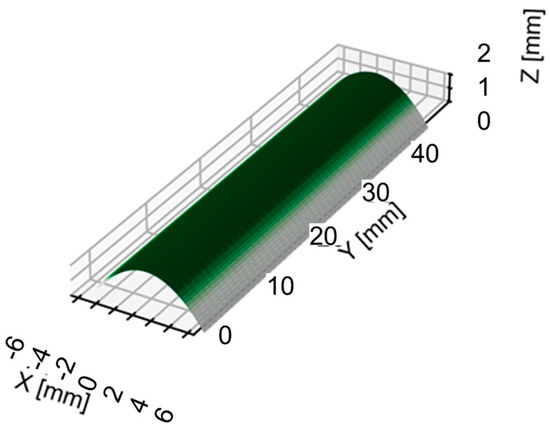
Figure 4.
Zero bead morphology 3D representation of the middle section of the first test.
The measuring and modeling of the zero bead geometry with arc-DED is a critical step in understanding and optimizing the process. The insights gained from these measurements can be used to ensure the consistent quality of the parts, enhance material properties, and optimize the design of arc-DED applications. Table 3 summarizes the results of the bead height (h) and bead width (w) for the manufacturing conditions. Three measurements are taken at locations along the trajectory of tests 1 to 9, denoted as w1, w2, and w3, and h1, h2, and h3. These measurements correspond to the widths (w1, w2, w3) and heights (h1, h2, h3) along the initial, middle, and final sections, respectively, of the 46 profiles extracted for each bead.

Table 3.
Height and width of the zero beads for the different test conditions.
The data indicates that there is a significant relationship between the welding parameters and the resulting bead dimensions. As the wire feed speed and deposition rate increase, the average bead width (w) and height (h) also increase. Conversely, increasing the traverse speed leads to a decrease in the average width and height of the beads.
This suggests that the wire feed speed and deposition rate primarily influence the heat input, while the traverse speed primarily affects the melt pool shape. In Figure 5, the correlation of the ratio and the wire feed speed with the width and height are shown. Looking at the evolution of the bead height and width, it follows that a higher ratio leads to a taller and wider bead, unlike the wire feed speed, which does not seem to have such a direct relationship, and is more likely to have a quadratic effect.
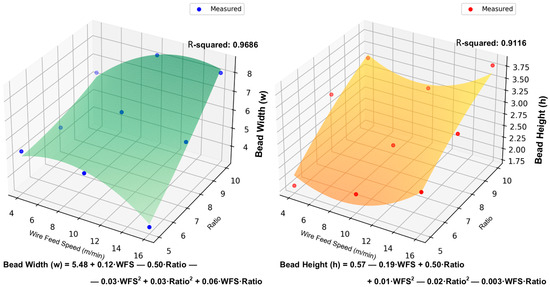
Figure 5.
Regression models for the calculation of the correlation of ratios and wire feed speed with bead width and bead height.
The implications of these findings for arc-DED Invar manufacturing are that the desired bead dimensions can be controlled via the adjustment of the welding parameters. For applications requiring wider and taller beads, higher wire feed speeds and deposition rates can be employed. As for the effect of currents and voltages in zero bead scenarios, although beyond the proposed test, it would have an impact on the melt behavior, solidification, and ultimately the geometry of the resulting bead. It is envisaged that the higher heat input will cause the melt pool to be wider, leading to a wider and lower bead. This analysis could be used to refine the manufacturing process, ensure consistency, and produce high quality weld beads in a variety of scenarios. For applications requiring narrower and shorter beads, higher traverse speeds can be used.
3.2. The Geometry Analysis of Wall Fabrication with Optimized Parameters
Figure 6 shows the results of the parabola model fitted to the profilometer data at each of the different arc-DED manufacturing conditions. The profilometer is located in the nozzle, and allows the transverse profile to be measured. This process is carried out offline. First, the formation of the bead is completed, allowing it to solidify, and then scanning is carried out using the profilometer to measure the transverse profile. The figure shows that the parabola model fits well to the profilometer data for all arc-DED manufacturing conditions. This suggests that the shape of the bead in the first pass is well described by a parabolic function.
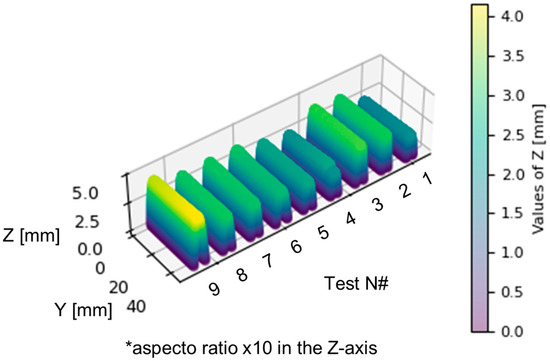
Figure 6.
Zero bead morphology of the whole test performed in Table 3; the parabola-modelled geometry from the data collected via the profilometer.
The parabola model can be used to predict the geometry of the bead manufactured using arc-DED. This information can optimize the manufacturing process and produce parts in situ between passes. The implementation of the parabola model focuses on two main objectives. Firstly, it aims to make the geometry of the bead as similar as possible to the desired and preprogrammed parabolic shape. Secondly, the goal is to maintain a consistent geometry to ensure a uniform layer during the layer-by-layer growth phase. Currently, this process is not performed online; however, there is the potential to transform this into an online solution via the implementation of a virtual sensor that deduces the key parameters of the parabola and/or through measurements made using the profilometer linked to the torch, albeit with a slight delay. Optimizing the bead shape involves adjusting the process parameters, such as the wire feed speed, the traverse speed, and the current, to achieve the predefined parabolic shape. These adjustments can be made individually or simultaneously, based on the specific design requirements. Integrating this optimization online during the manufacturing process would allow for greater adaptability and precision, thus enhancing the real-time consistency of the bead.
The parabola model and its relationship to the monitored parameters can be used to feed a neural network to serve as a virtual sensor of the bead geometry, thus replacing the scan times of the profilometer. This information could be used to select the in situ manufacturing conditions to reduce shape distortion effect sources during the build-up process of parts.
3.3. The Data Monitoring of the DED Process on Invar
The data provided from the mold manufacturing process (Figure 7) proves to be invaluable in enhancing the overall efficiency and quality of the manufacturing process. The chosen geometry is a reference geometry for molds in the aeronautical sector, and has been proposed by companies in the sector. The signals have been acquired at a rate of one hertz, one data per second, as we are not looking for a dynamic reaction to the process, but for a change in the quasi-static state. The signals acquired are the same as in all the tests shown in this work. Through a meticulous analysis of this data, various trends and patterns emerge, shedding light on areas that require attention and improvement. For example, temperature data can identify the regions of the mold that experience higher temperatures, or where the heat concentrates, allowing for corrective actions to be taken in subsequent passes. Such insights may signify issues with the cooling system or point to inadequacies in the mold part design. This design has been used in previous works [34].
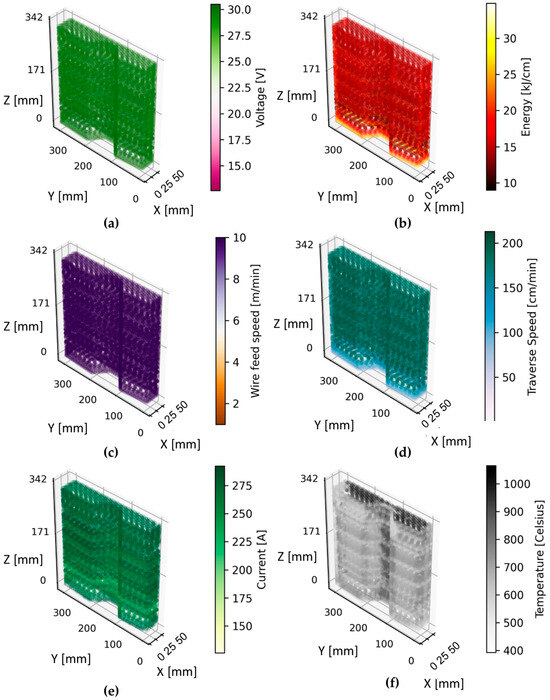
Figure 7.
Data collected from the numerical control of the machine and sensor: (a) voltage, (b) energy, (c) wire feed speed, (d) traverse speed, (e) current, and (f) temperature.
The feed rate data become a crucial metric in determining whether the wire feeder operates at the appropriate speed. This ensures the uniform solidification of the mold part, contributing to higher quality outcomes. The energy data play a pivotal role in assessing the wire feeder’s energy consumption. Optimizing energy usage not only reduces production costs, but also enhances the overall process efficiency.
Mold manufacturing process monitoring, facilitated by comprehensive data analysis, emerges as a powerful tool for refining efficiency, quality, and profitability. The insights gained from these data pave the way for continuous improvement throughout the various phases of the manufacturing process. In a three-dimensional context with Cartesian X, Y and Z axes in millimeters, the visual representation in Figure 7 is a three-dimensional graph showing the evolution of six key process parameters over time. Each of the collected variables is represented in a subplot, and the color in the graph would represent the value of the property at each three-dimensional point. In Figure 7, the variables represented are as follows: (a) the voltage which remains constant during most of the process; (b) the energy per unit length, which is higher in the lower layers when encountering the colder substrate, and then decreases in value; (c) the wire feed speed; (d) the transverse feed speed; (e) the current; and (f) the temperature which is raised in the area where it is higher in the straight section. Temperatures were measured using a pyrometer on the torch, capturing the surface temperatures of the bead at a given distance from the molten pool. This temperature data can be used to optimize the welding process in two key respects. First, it allows for the precise control of bead geometry via correlating temperature variations with the desired shape; at lower temperatures, a narrower and taller bead is estimated, while at higher temperatures, a wider and shorter bead is estimated. Secondly, the data help to detect defects by identifying cold areas, which indicated a lack of fusion, and high temperatures, which indicate possible porosity due to gas accumulation. This early detection of defects allows corrective action to be taken in time, thus ensuring the production of high-quality beads. As this is not a direct melt pool measurement, the correlations and measurements are not reliable, but are expected to be effective in combination with the other measured parameters and through artificial intelligence modelling.
Utilizing the data to identify trends and patterns can help predict potential issues. For instance, an increase in mold temperature may signal a cooling system problem, thus prompting timely intervention. Also, adjusting process parameters could be addressed. The data aids in adjusting parameters to enhance efficiency and quality. If the feed rate data reveal uneven solidification, adjustments can be made to ensure uniformity. Also, this could lead to a reduction in costs via a detailed analysis of the energy data, which can potentially uncover opportunities to minimize production costs. Identifying excess energy usage can lead to strategies for energy conservation. Figure 8 shows the mold produced by arc-DED, which is the subject of this study. Material detachments can be observed in the corners, due to the change of direction in the deposition, which can allow for the detection of which should be studied for later improvements of the manufacturing process.
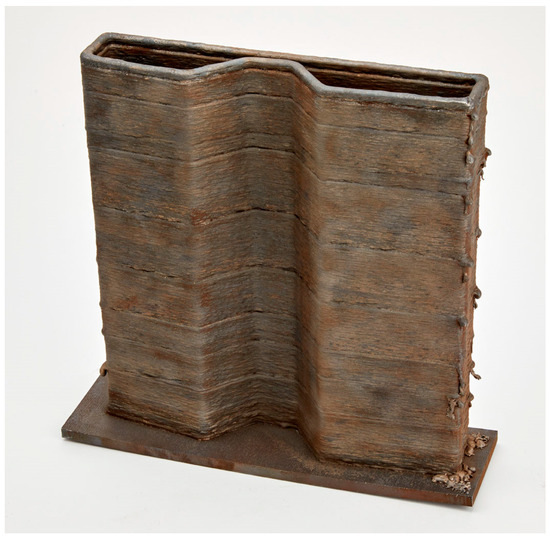
Figure 8.
The mold manufactured by arc-DED used on Invar material.
4. Neural Network Model
In this subsection, a virtual sensor emerges as a data-driven alternative to traditional physical sensors, enabling the continuous monitoring and analysis of weld bead geometry without requiring direct physical contact with the weld zone. This virtual sensor harnesses the power of machine learning algorithms, particularly neural networks, to establish a correlation between the process parameters and weld bead characteristics.
The sensor’s core ability is to extract meaningful insights from process monitoring data, encompassing parameters like wire feed speed, voltage, current, travel speed, energy, and pyrometer temperature, as can be seen in Figure 9a, following the same procedure as for the mold data. There are forty-six control point in the nine tests performed, as described in Table 2. These data form the input layer of the neural network model, which serves as the sensor’s analytical engine.
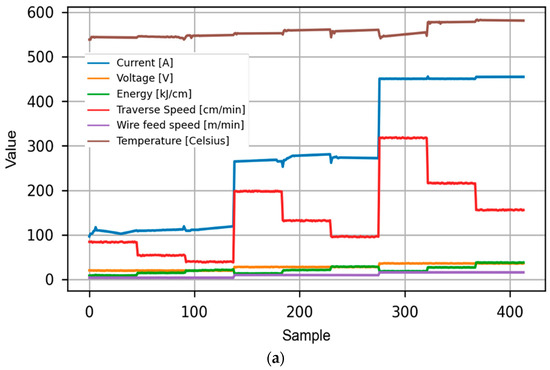
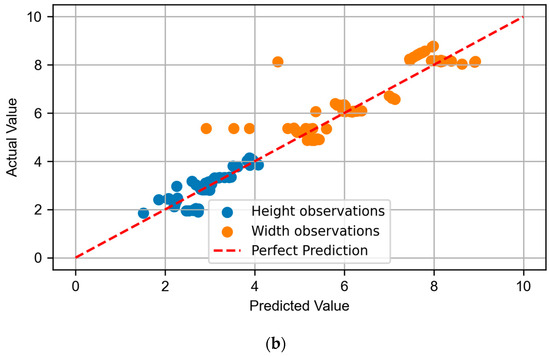
Figure 9.
Zero bead estimation: (a) input parameters and (b) actual values versus predicted values in the test observations () using the neuronal network model.
The welding process is closely influenced by several key input parameters for the neural networks model. Firstly, voltage plays a crucial role in controlling arc length and heat input. Energy per unit length, another critical factor resulting from the current, voltage, and traverse speed, directly influences the heat input to the weld, thus affecting the depth of the penetration and the bead shape. In addition, the wire feed speed dictates the deposition rate of the wire. Conversely, the transverse speed, which governs the movement of the torch perpendicular to the welding direction, can alter the shape and width of the bead, depending on the speed employed. Current levels regulate the heat generated in the arc. Finally, the temperature, a product of the welding process, has a profound influence on the material properties and geometry of the bead.
The neural network model, trained on a comprehensive dataset of weld bead measurements which were obtained using physical sensors and profilometers, learns to map the intricate relationships between process parameters and weld bead geometry. This trained model constitutes the virtual sensor’s intelligence, thus enabling it to predict weld bead geometry for new process conditions without any physical interaction.
The neural network model at the heart of the virtual sensor employs a series of interconnected nodes, mimicking the structure of the human brain. These nodes process information, performing complex calculations and passing the processed information to subsequent nodes in a hierarchical manner.
The input layer of the model receives the process monitoring data, represented as vectors of numerical values. These vectors are transformed into features that capture the essence of the process conditions. The transformed features are then fed into the hidden layers of the neural network, where they undergo a series of mathematical operations. The hidden layers, typically comprising multiple layers, introduce non-linearities into the model, enabling it to capture the complex relationships between the features and the weld bead geometry. The output of the hidden layers is then passed through an output layer, which generates the predicted weld bead geometry, represented as a parabola that accurately represents the bead’s shape and dimensions.
The neural network model predicts the height and width of the weld beads based on various input parameters, such as amperage, voltage, speed, gas, energy, wire, and temperature. The code follows the following methodology, using the libraries (sklearn.model_selection and tensorflow). These libraries are used for data manipulation, data splitting, and model training, respectively. The code employs experimental test data with different welding conditions. The data collected are six input variables (wire feed speed, voltage, current, travel speed, energy, and pyrometer temperature) for the forty-six control points of the nine beads defined in Table 2, as discussed in the results Section 3.1. The data are split into training and testing sets. The training set is used to train the model (80% of the data), while the testing set (20% of the data) is used to evaluate the model’s performance on unseen data. The model consists of an input layer, two hidden layers with 100 and 50 neurons, respectively, and an output layer with two neurons corresponding to the height and width of the weld beads. The model is compiled using the Adam optimizer, the mean squared error (MSE) loss function, and a precision metric. This model has a test loss of 0.144 and a perfect test accuracy of 1.0, demonstrating its remarkable ability to predict weld bead geometry from process parameters alone. The model’s performance is evaluated on the test set, 0.2 (percentage of the total data set) × 9 (beads with different welding conditions) × 46 (control points), as shown in Figure 9b. The fact that the points on the validation graph are clustered around the line of perfect prediction indicates that the model is predicting real values with a fair degree of accuracy. However, it would be important to conduct further tests in order to confirm these results. This could be performed via increasing the size of the test dataset or using a different test dataset altogether. It would also be crucial to analyze the model’s errors to identify any trends or patterns that may indicate an issue with the model.
Figure 10 shows the fabricated welding bead from the ninth test, with the direct deposition arc welding (DED) process. The cross-section, considered to be the weld profile shown in the image, is typical of a DED weld. The weld has a parabolic shape, almost perfectly matching the raw data from the profilometer with its regression model, with a wide melt region at the bottom, and a narrow bead region at the top. The virtual sensor correctly defines the shape by fitting closely to both the regressed parabola and the raw points. For its conception, the error is associated with the fact that the center of the parabola is not the physical center, as it has a certain flattening to the right in positive values of the abscissa axis.
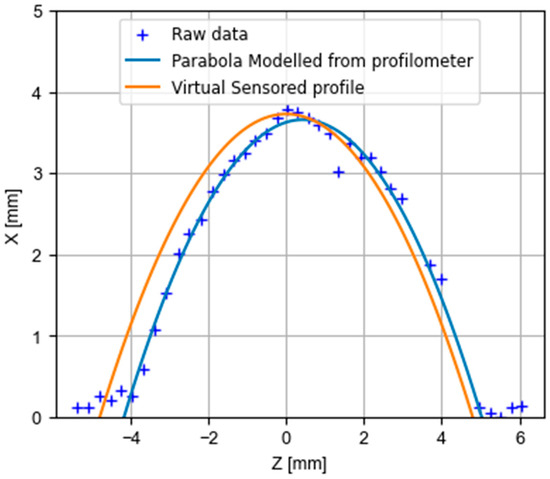
Figure 10.
Zero bead morphology comparison between raw data from the profilometer, the parabola modeled bead, and the virtual sensor estimated geometry from the neuronal network model in test nine arc-DED manufacturing conditions.
The virtual sensor’s ability to predict weld bead geometry in real-time opens up a plethora of applications: (i) Real-time monitoring and defect detection—the virtual sensor can continuously monitor weld bead geometry, alerting operators to potential defects such as undercut, a lack of fusion, or excessive bead height; (ii) Automated process control—the predicted weld bead geometry can guide the automation of the welding process, optimizing parameters like wire feed speed and travel speed in order to achieve the desired weld characteristics; and (iii) Quality assurance—the virtual sensor can evaluate the quality of weld beads by comparing the predicted geometry to the actual geometry measured using a physical sensor. This comparison can identify defects and ensure consistent weld quality.
The virtual sensor, powered by a neural network model, represents a transformative advancement in weld bead monitoring and control, thus paving the way for enhanced weld quality, improved process efficiency, and reduced production costs.
5. Conclusions
This paper introduces the additive manufacturing of an Invar mold using three-dimensional printing with arc-DED technology. However, its success is not solely based on this; it relies on the development of online inspection and monitoring techniques. Some of the conclusions that can be drawn are as follows:
- A range of manufacturing conditions has been studied, considering the feed rate and wire speed in the deposition of Invar.
- The geometry of the weld bead has been systematically characterized for various welding parameters. It has been observed that profiles obtained through the direct measurement of the bead using a laser profilometer consistently align with a parabolic regression. The quantitative assessment reveals that R-squared values for the regression, derived from the 46 profiles taken from the initial tested bead, range from 0.807 to 0.948, with a mean value of 0.887. This statistical analysis indicates that, on average, the model explains approximately 88.7% of the variability in the data, affirming the robustness of the parabolic regression fit to the observed bead profiles.
- Monitoring data have been extracted throughout the fabrication process of an Invar mold using arc-DED technology. The data collection spanned a duration of 1 h and 34 min, employing a strategy that adapted the conditions.
- A virtual sensor methodology has been established, enabling the indirect measurement of bead geometry through a neural network model, fed with process monitoring data. This innovative approach employs a feedforward neural network (FNN), where the internal signals act as input, and the resulting height and width of the bead constitute the output. Moreover, this neural network model has demonstrated a robust performance, with a test loss of 0.144 and a test accuracy reaching 1.0, underscoring its efficacy in predicting weld bead geometry based on process parameters.
- Measurements made with the profilometer, and the virtual sensor have been compared, showing a high level of precision.
Future lines of research aim to extend the model to beads above the zero bead, as well as to explore other materials and additive manufacturing technologies.
Author Contributions
Conceptualization, F.V. and A.S.; data curation, A.F.-Z. and F.V.; formal analysis, A.F.-Z. and F.V.; investigation, F.V. and A.S.; methodology, A.F.-Z. and F.V.; project administration, A.S. and J.R.A.L.; supervision, J.R.A.L. and A.S.; validation, J.R.A.L. and A.S.; writing—original draft, A.F.-Z. and F.V.; writing—review and editing, A.F.-Z., J.R.A.L. and A.S. All authors have read and agreed to the published version of the manuscript.
Funding
This study was supported as part of the ADDILANZA project by the Euroregion Nouvelle-Aquitaine Euskadi Navarra under the “Euroregional Innovation” program.
Institutional Review Board Statement
Not applicable.
Informed Consent Statement
Not applicable.
Data Availability Statement
The data presented in this study are available on request from the corresponding author.
Conflicts of Interest
The authors declare no conflicts of interest.
References
- Chaturvedi, M.; Scutelnicu, E.; Rusu, C.C.; Mistodie, L.R.; Mihailescu, D.; Subbiah, A.V. Wire Arc Additive Manufacturing: Review on Recent Findings and Challenges in Industrial Applications and Materials Characterization. Metals 2021, 11, 939. [Google Scholar] [CrossRef]
- Li, K.; Chen, W.; Gong, N.; Pu, H.; Luo, J.; Zhang, D.Z.; Murr, L.E. A Critical Review on Wire-Arc Directed Energy Deposition of High-Performance Steels. J. Mater. Res. Technol. 2023, 24, 9369–9412. [Google Scholar] [CrossRef]
- Svetlizky, D.; Das, M.; Zheng, B.; Vyatskikh, A.L.; Bose, S.; Bandyopadhyay, A.; Schoenung, J.M.; Lavernia, E.J.; Eliaz, N. Directed Energy Deposition (DED) Additive Manufacturing: Physical Characteristics, Defects, Challenges and Applications. Mater. Today 2021, 49, 271–295. [Google Scholar] [CrossRef]
- Gardner, L. Metal Additive Manufacturing in Structural Engineering—Review, Advances, Opportunities and Outlook. Structures 2023, 47, 2178–2193. [Google Scholar] [CrossRef]
- Kumar, N.; Bhavsar, H.; Mahesh, P.V.S.; Srivastava, A.K.; Bora, B.J.; Saxena, A.; Dixit, A.R. Wire Arc Additive Manufacturing—A Revolutionary Method in Additive Manufacturing. Mater. Chem. Phys. 2022, 285, 126144. [Google Scholar] [CrossRef]
- Wang, F.; Williams, S.; Colegrove, P.; Antonysamy, A.A. Microstructure and Mechanical Properties of Wire and Arc Additive Manufactured Ti-6Al-4V. Met. Mater Trans. A 2013, 44, 968–977. [Google Scholar] [CrossRef]
- Wu, B.; Pan, Z.; Ding, D.; Cuiuri, D.; Li, H.; Xu, J.; Norrish, J. A Review of the Wire Arc Additive Manufacturing of Metals: Properties, Defects and Quality Improvement. J. Manuf. Process. 2018, 35, 127–139. [Google Scholar] [CrossRef]
- Jiao, G.; Fang, X.; Chen, X.; Xi, N.; Zhang, M.; Liu, Y.; Wu, H.; Huang, K. The Origin of Low Thermal Expansion Coefficient and Enhanced Tensile Properties of Invar Alloy Fabricated by Directed Energy Deposition. J. Mater. Process. Technol. 2023, 317, 117994. [Google Scholar] [CrossRef]
- Veiga, F.; Suárez, A.; Artaza, T.; Aldalur, E. Effect of the Heat Input on Wire-Arc Additive Manufacturing of Invar 36 Alloy: Microstructure and Mechanical Properties. Weld. World 2022, 66, 1081–1091. [Google Scholar] [CrossRef]
- Qiu, C.; Adkins, N.J.E.; Attallah, M.M. Selective Laser Melting of Invar 36: Microstructure and Properties. Acta Mater. 2016, 103, 382–395. [Google Scholar] [CrossRef]
- Yakout, M.; Elbestawi, M.A.; Veldhuis, S.C. Density and Mechanical Properties in Selective Laser Melting of Invar 36 and Stainless Steel 316L. J. Mater. Process. Technol. 2019, 266, 397–420. [Google Scholar] [CrossRef]
- Clark, D.; Bache, M.R.; Whittaker, M.T. Shaped Metal Deposition of a Nickel Alloy for Aero Engine Applications. J. Mater. Process. Technol. 2008, 203, 439–448. [Google Scholar] [CrossRef]
- Gil Del Val, A.; Cearsolo, X.; Suarez, A.; Veiga, F.; Altuna, I.; Ortiz, M. Machinability Characterization in End Milling of Invar 36 Fabricated by Wire Arc Additive Manufacturing. J. Mater. Res. Technol. 2023, 23, 300–315. [Google Scholar] [CrossRef]
- Honeycutt, A.; Mhatre, P.; Gibson, B.; Smith, S.; Richardson, B. Iterative Hybrid Manufacture of a Titanium Alloy Component. Manuf. Lett. 2021, 29, 90–93. [Google Scholar] [CrossRef]
- Yakout, M.; Elbestawi, M. Residual Stress Formation in Laser-Based Powder Bed Fusion (PBF-LB) of Invar 36; ASTM International: West Conshohocken, PA, USA, 2020; pp. 34–44. ISBN 978-0-8031-7708-6. [Google Scholar]
- Qiu, C.; Liu, Y.; Liu, H. Influence of Addition of TiAl Particles on Microstructural and Mechanical Property Development in Invar 36 Processed by Laser Powder Bed Fusion. Addit. Manuf. 2021, 48, 102457. [Google Scholar] [CrossRef]
- Sebbe, N.P.V.; Fernandes, F.; Sousa, V.F.C.; Silva, F.J.G. Hybrid Manufacturing Processes Used in the Production of Complex Parts: A Comprehensive Review. Metals 2022, 12, 1874. [Google Scholar] [CrossRef]
- Ding, D.; Pan, Z.; Cuiuri, D.; Li, H. A Multi-Bead Overlapping Model for Robotic Wire and Arc Additive Manufacturing (WAAM). Robot. Comput.-Integr. Manuf. 2015, 31, 101–110. [Google Scholar] [CrossRef]
- Dinovitzer, M.; Chen, X.; Laliberte, J.; Huang, X.; Frei, H. Effect of Wire and Arc Additive Manufacturing (WAAM) Process Parameters on Bead Geometry and Microstructure. Addit. Manuf. 2019, 26, 138–146. [Google Scholar] [CrossRef]
- Ding, D.; Pan, Z.; Cuiuri, D.; Li, H.; van Duin, S.; Larkin, N. Bead Modelling and Implementation of Adaptive MAT Path in Wire and Arc Additive Manufacturing. Robot. Comput.-Integr. Manuf. 2016, 39, 32–42. [Google Scholar] [CrossRef]
- Veiga, F.; Suárez, A.; Aldalur, E.; Bhujangrao, T. Effect of the Metal Transfer Mode on the Symmetry of Bead Geometry in WAAM Aluminum. Symmetry 2021, 13, 1245. [Google Scholar] [CrossRef]
- Pinto-Lopera, J.E.; Motta, J.M.S.T.; Absi Alfaro, S.C. Real-Time Measurement of Width and Height of Weld Beads in GMAW Processes. Sensors 2016, 16, 1500. [Google Scholar] [CrossRef] [PubMed]
- Wang, X.; Meng, D.; Yi, H.; Yan, Z.; Xiao, J.; Chen, S. A Novel Model for Directed Energy Deposition-Arc Based on in-Order Stacking of Primitives. Virtual Phys. Prototyp. 2024, 19, e2291471. [Google Scholar] [CrossRef]
- Ding, D.; Zhao, R.; Lu, Q.; Pan, Z.; Li, H.; Wang, K.; He, K. A Shape Control Strategy for Wire Arc Additive Manufacturing of Thin-Walled Aluminium Structures with Sharp Corners. J. Manuf. Process. 2021, 64, 253–264. [Google Scholar] [CrossRef]
- Ding, D.; Yuan, L.; Huang, R.; Jiang, Y.; Wang, X.; Pan, Z. Corner Path Optimization Strategy for Wire Arc Additive Manufacturing of Gap-Free Shapes. J. Manuf. Process. 2023, 85, 683–694. [Google Scholar] [CrossRef]
- Halisch, C.; Radel, T.; Tyralla, D.; Seefeld, T. Measuring the Melt Pool Size in a Wire Arc Additive Manufacturing Process Using a High Dynamic Range Two-Colored Pyrometric Camera. Weld. World 2020, 64, 1349–1356. [Google Scholar] [CrossRef]
- Dellarre, A.; Limousin, M.; Beraud, N. Melt Pool Acquisition Using Near-Infrared Camera in Aluminum Wire Arc Additive Manufacturing. In Proceedings of the Advances on Mechanics, Design Engineering and Manufacturing IV; Gerbino, S., Lanzotti, A., Martorelli, M., Mirálbes Buil, R., Rizzi, C., Roucoules, L., Eds.; Springer International Publishing: Cham, Switzerland, 2023; pp. 803–814. [Google Scholar]
- Richter, A.; Gehling, T.; Treutler, K.; Wesling, V.; Rembe, C. Real-Time Measurement of Temperature and Volume of the Weld Pool in Wire-Arc Additive Manufacturing. Meas. Sens. 2021, 17, 100060. [Google Scholar] [CrossRef]
- Mattera, G.; Nele, L.; Paolella, D. Monitoring and Control the Wire Arc Additive Manufacturing Process Using Artificial Intelligence Techniques: A Review. J. Intell. Manuf. 2024, 35, 467–497. [Google Scholar] [CrossRef]
- Lopez, A.B.; Sousa, J.P.; Pragana, J.P.M.; Bragança, I.M.F.; Santos, T.G.; Silva, C.M.A. In Situ Ultrasonic Testing for Wire Arc Additive Manufacturing Applications. Machines 2022, 10, 1069. [Google Scholar] [CrossRef]
- Shah, A.; Aliyev, R.; Zeidler, H.; Krinke, S. A Review of the Recent Developments and Challenges in Wire Arc Additive Manufacturing (WAAM) Process. J. Manuf. Mater. Process. 2023, 7, 97. [Google Scholar] [CrossRef]
- ASTM-B753-01; Standard Specification for Thermostat Component Alloys. ASTM International: West Conshohocken, PA, USA, 2018.
- Tang, S.; Guilan Wang, C.H.; Zhang, H. Investigation and control of weld bead ar both ends in WAAM. In Proceedings of the 30th Annual International Solid Freeform Fabrication Symposium and Additive Manufacturing Conference, Austin, TX, USA, 12–14 August 2019. [Google Scholar]
- Aldalur, E.; Suárez, A.; Veiga, F. Thermal Expansion Behaviour of Invar 36 Alloy Parts Fabricated by Wire-Arc Additive Manufacturing. J. Mater. Res. Technol. 2022, 19, 3634–3645. [Google Scholar] [CrossRef]
Disclaimer/Publisher’s Note: The statements, opinions and data contained in all publications are solely those of the individual author(s) and contributor(s) and not of MDPI and/or the editor(s). MDPI and/or the editor(s) disclaim responsibility for any injury to people or property resulting from any ideas, methods, instructions or products referred to in the content. |
© 2024 by the authors. Licensee MDPI, Basel, Switzerland. This article is an open access article distributed under the terms and conditions of the Creative Commons Attribution (CC BY) license (https://creativecommons.org/licenses/by/4.0/).